Sigma A 18-35 mm f/1.8 DC HSM
3. Build quality
The Sigma compares here pretty favourably – although it features the highest number of optical elements and it is the fastest, it remains, along with the Pentax, also physically the lightest. Along with the Canon it also offers an ultrasonic autofocus drive like no other instrument of this group. Its angle of view is the widest and when it comes to the minimum focusing distance it leaves all the rivals far behind. The Sigma is a long lens (only the Nikkor is slightly longer) but clearly the narrowest.
In the photo below the tested lens is positioned next to the full frame Nikkor 24-70 mm f/2.8 and the Canon EF 50 mm f/1.4 USM.
Please Support UsIf you enjoy our reviews and articles, and you want us to continue our work please, support our website by donating through PayPal. The funds are going to be used for paying our editorial team, renting servers, and equipping our testing studio; only that way we will be able to continue providing you interesting content for free. |
- - - - - - - - - - - - - - - - - - - - - - - - - - - - - - - - - - - - - - - - - - - - - - - -
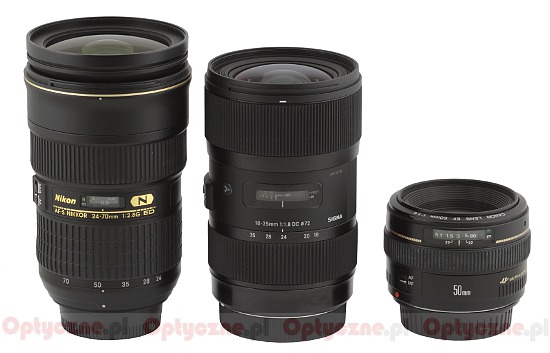 |
The Sigma A 18-35 mm f/1.8 DC HSM starts with a metal mount which surrounds the contacts and a rear element of the lens, 29 mm in diameter. The element is on the same level as the mount when the focal length is set at 18 mm and it hides 2-3 mm deep inside the barrel when you pass to 35 mm. That movement is so slight that it doesn’t create any gap between the rim of the element’s housing and the barrel of the lens. It means the dirt and dust won’t have an easy access inside the tube.
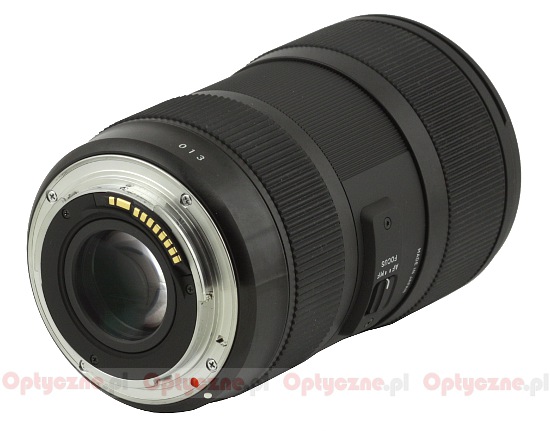 |
A black, smooth metal ring with a white dot, making an alignment with a camera easier, is the first element of the proper casing; you can also find the “013” symbol, marking the year of production.
Further on you meet a zoom ring, 24 mm wide; most of it is occupied by rubber ribbing above which you can find focal lengths markings at 18, 20, 24, 28 and 35 mm. The ring moves smoothly and is well-damped.
Then you see an immobile part of the casing with the name and parameters of the lens, above which you can find a distance scale behind a window, expressed in meters and feet. On the left side of the scale there is an “A” letter meaning this lens is qualified as “Art” instrument and a bit further one a focusing mechanism mode switch (AF/MF) next to which you can find an inscription “Made in Japan”.
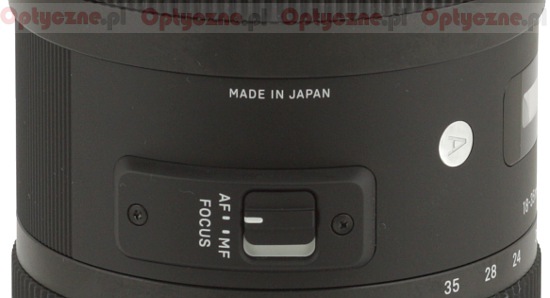 |
At the end of the lens’s tube there is a manual focus ring, as wide as 35 mm. Most of its width is taken by ribs, very pleasant to the touch. It works very evenly, without any slacks or jumps. Running through the whole distance scale needs a turn through about 130 degrees.
Behind the manual focus ring you can only find a hood mount for a petal-type hood added in the box with the lens. The front element is 49 mm in diameter, slightly convex and immobile at the same time. It is surrounded by a filter thread, 72 mm in diameter. It is an interesting solution, by the way because there is a lot of space left between the edge of the element and the filter thread, filled by a slightly gouged part of the casing, going round the element. If it was a bit higher and threaded you could attach a 58 mm filter there.
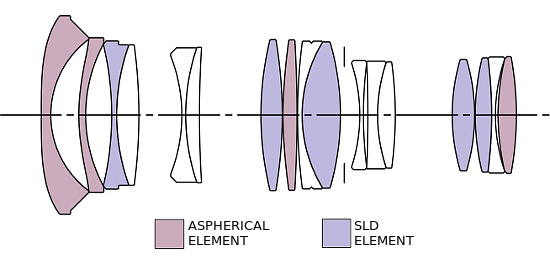 |
When it comes to the optical construction of the lens we deal here with 17 elements positioned in 12 groups. The constructor of the lens, like in the case of the Sigma 1.4/35, evidently knew what the special glass and untypical elements are for and didn’t hesitate to use them. Overall we have here as many as five low dispersion SLD glass elements and four aspherical ones. Inside you can also find a circular aperture with nine blades which can be closed down to a value of f/16. Everything is closed inside a new, stylish Sigma casing.
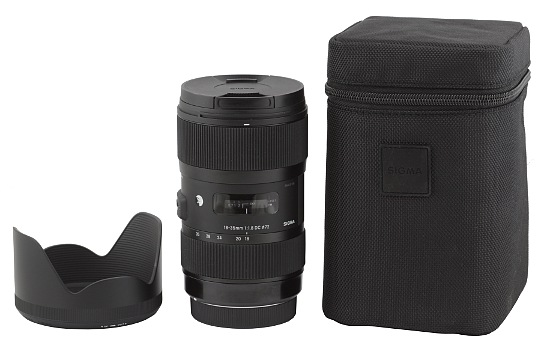 |
Buyers get both caps, a petal-type hood and a stylish, hard case which can be additionally attached to your belt.






